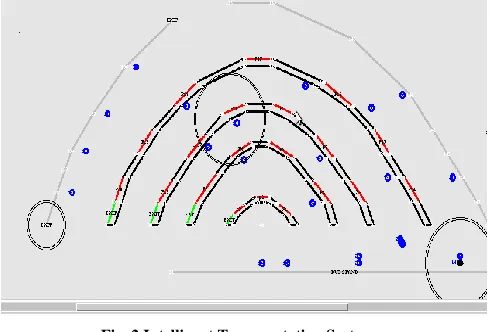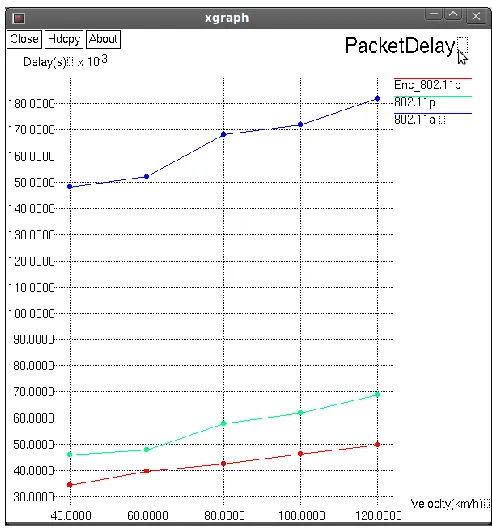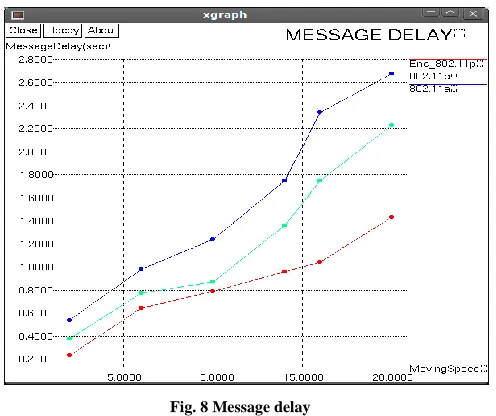International Journal of Emerging Technology and Advanced Engineering
Website: www.ijetae.com (ISSN 2250-2459,ISO 9001:2008 Certified Journal, Volume 4, Issue 3, March 2014)
56
Intelligent Transportation System for Vehicular Ad-Hoc
Networks
T. Sujitha
1, S. Punitha Devi
2 1,2Department of CSE, P.A College of Engineering and Technology, Coimbatore, Tamilnadu
Abstract - Vehicular ad hoc networks (VANETs) are a one form of wireless networks. It is used for communication between vehicles on roads. The conventional routing protocols are suitable for mobile ad hoc networks (MANETs). But it’s poorly in VANETs. As communication links break often happen in VANETs compare than in MANETs, the reliable routing is more difficult in the VANET. Research work has been done to the routing reliability of VANETs on highways. In this paper, we use the intelligent transportation system for VANETs. The intelligent transportation system helps to capture the future positions of the vehicles and determines the reliable routes preemptively. This paper is the first to propose an intelligent transportation system gives reliable routing process. A new mechanism is developed to find the vehicles information from the source vehicle to the destination vehicle. Through the simulation results, that the proposed scheme significantly give good result compare than other literature survey.
Keywords - Vehicular Ad-hoc Network (VANET), DSRC, IEEE 802.11, Sensor, OBU, RSU.
I. INTRODUCTION
Every day, a most of people die, and many people are injured in traffic accidents around the world. The desire to improve road safety information between vehicles to prevent accidents and also improve road safety was the main motivation behind the development of vehicular ad hoc networks (VANETs). VANETs are a promising technology to enable Communication among vehicles on roads. They are a special form of mobile ad hoc networks
(MANETs) that provide vehicle-to-vehicle
communications. It is assumed that each vehicle is equipped with a wireless communication facility to provide ad hoc network connectivity.
VANETs tend to operate without an infrastructure, each and every vehicle in the network can send, receive messages to other vehicles in the network. Intelligent Transportation System (ITS) that will change our way to drive and help emergency services. VANETs allow vehicles to easily communicate among them and also with fixed infrastructure. This will not only improve the overall road safety, but also raise new commercial opportunities.
Each vehicle is equipped with a short range communication device and controller nodes are placed in
the intersection with traffic lights. Our proposal manages
traffic information seeking to avoid accidents, although the information here is gathered from the vehicles themselves so no further infrastructure is needed.
Fig.1 Structure of Vanet Ad-hoc Networks
This way, vehicles can exchange real-time information, and drivers can be informed about road traffic conditions and other travel-related information. The most challenging issue is potentially the high mobility and the frequent changes of the network topology.
In VANETs, the network topology could vary when the vehicles change their velocities and/or lanes. These changes depend on the drivers and road situations and are
normally not scheduled in advance. Embedded wireless
devices are the main components of evolving cooperative active safety systems for vehicles. These systems, which rely on communication between vehicles, deliver warning messages to drivers and may even directly take control of the vehicle of such applications, including communication and detection of vehicle information are tightly coupled with physical dynamics of vehicles and drivers behavior. Recent research on such cooperative vehicle safety (CVSS)
systems has shown that significant performance
International Journal of Emerging Technology and Advanced Engineering
Website: www.ijetae.com (ISSN 2250-2459,ISO 9001:2008 Certified Journal, Volume 4, Issue 3, March 2014)
57
The types of possible actions and warnings in vehicle safety systems range from low-latency collision avoidance or warning systems to moderate-latency system that provide heads up information about possible dangers in the non immediate path of the vehicle. The main differences of these systems are the sources and means of information dissemination and acquisition. In active safety systems, vehicles are required to be continuously aware of their neighborhood of few hundred meters and monitor possible emergency information. This task can be achieved by frequent real time communication between vehicles over dedicated short range communication (DSRC) channel. In addition to inter-vehicle communication; roadside devices may also assist vehicles in learning about their environment by delivering traffic signal or pedestrian related information at intersections. The main requirement of these active safety systems is the possibility of delivering real-time acquired information to and between vehicles at latencies of lower than few hundred milliseconds. Prototypes of such systems are being developed by many automotive manufacturers.II. RELATED WORK
In DSRC based safety systems, the cyber components are selected so that they meet the requirements of active safety. Nevertheless, the existing designs fall short of supporting a full-fledged CVSS in which a large number of vehicles communicate and cooperate with each other. The traditional design of the CVSS system, based on the structure described, is a open design following the recommendations of an early report by vehicle safety communication consortium (VSCC). According to this report information, it is suggested that vehicles would transmit tracking messages every 100ms, to a distance of at least 150m (avg. 250m). The DSRC radio power is set to reaches the suggested distance. Given the issues of the above design in the networks, several enhancements have been recently proposed to improve the performance of CVSS systems across the early solutions set by VSCC.
A message dispatcher is proposed to reduce required data rate by removing unwanted elements, here, the idea is that many applications require the same data elements to perform evasive maneuvers. The message dispatcher at the sender side will group data elements from application layer (i.e., the source) and decides how frequently each data element should be broadcast. The above methods focus on the computing module, as defined in this section, and try to improve its performance through observing the behavior of the application, or by incorporating limited physical process information in the design of the computing module.
While the above improvements do enhance the performance of CVSS systems, these designs do not
consider the mutual effects of computation,communication
and physical processes on each other. In this, try to identify such mutual effects and propose a design that uses the knowledge of the tight coupling of cyber and physical processes to the benefit of a CVSS system.
A.
D
estinationS
equencedD
istanceV
ector (Dsdv)DSDV is a proactive protocol that maintains route to all the destinations before requirement of the route. Each node maintains a routing table which contains next hop, cost metric towards each destination and a sequence number that is created by the destination itself. This table is exchanged by each node to update route information. A node transmits routing table periodically or when significant new information is available about some route. Whenever a node wants to send packet, it uses the routing table stored locally.
For each destination, a node knows which of its neighbor leads to the shortest path to the destination. DSDV is an efficient protocol for route discovery process. Hence, latency for route discovery is very low. DSDV also guarantees loop-free paths.
III. PROTOCOL IMPLEMENTATION
Dedicated Short Range Communications (DSRC) is a short to medium range communications service that was developed to support vehicle-to-vehicle and vehicle-to-road side communications. DSRC is aimed at providing high data transfers and low communication latency in small communication zones.VANET are becoming more and more popular as a way to increase the traffic safety and comfort driving. The IEEE 802.11p MAC protocol has attracted much attention as part of the WAVE protocol in VANETs.
IV. PERFORMANCE EVALUATION
International Journal of Emerging Technology and Advanced Engineering
Website: www.ijetae.com (ISSN 2250-2459,ISO 9001:2008 Certified Journal, Volume 4, Issue 3, March 2014)
58
Channel reuse is permitted in different node clusters. The number of nodes contending for the channel varies from 20 to 250.A) Packet arrival rate
Total ratio of the number of received data packets to the number of total data packets sent by the source.
B) Average end-to-end delay
The average time for delivering a data packet is an successful transmission.
V.INTELLIGENT TRANSPORTATION SYSTEM
As emerging vehicle-to-vehicle ad hoc networks ex-tend existing roadside infrastructures (e.g. sensors, access points
and centralized servers), it isimperative to understand their
impact on end-user ITS applications that will utilize these networks and more importantly to isolate fundamental performance limitations of VANETs in order to expand their applicability to support appropriate higher level application services. Test bed environments are an important component that may be used to evaluate new techniques, system designs and architectures. However experimentation in operational transportation systems is costly, can be dangerous, does not scale well and often does not provide sufficient means of control for comprehensive experimentation. Simulated systems are capable of overcoming these limitations. As both traffic conditions and network communication patterns are highly variable and unpredictable, simulation tools that include not only accurate communication network models but also realistic transportation models are vital to assess the benefits of ITS in a planning mode as well as to generate scenarios, optimize control and predict network behavior at the operational level for transportation professionals to develop effective traffic management systems and to compare transportation alternatives.
In this paper, we provide a comprehensive evaluation of mobility impact on the IEEE 802.11p MAC performance. The study evaluates basic performance metrics such as packet delivery ratio, throughput, and delay. An unfairness problem due to the relative speed is identified for both broadcast and unicast scenarios. We propose two dynamic contention window mechanisms to alleviate network performance degradation due to high mobility. The first scheme provides dynamic level of service priority via adaptation to the number of neighboring nodes, while the second scheme provides service priority based on node relative speed.
Extensive simulation results demonstrate a significant impact of mobility on the IEEE 802.11p MAC performance, the unfairness problem in the vehicle-to-vehicle (V2V) communications, and the effectiveness of the proposed MAC schemes.
VI. RESULTS
[image:3.612.325.570.295.461.2]Intelligent Transportation System mechanism was compared with three different strategies and three strategies were analyzed in order to choose the best one among these strategies for vehicle communication. The performance evaluation metrics, the comparison of the Strategies and results have been described through the NS2 Simulator.
Fig. 2 Intelligent Transportation System
Above Fig. 2 shows number of nodes can be created in the network..
[image:3.612.325.568.501.707.2]International Journal of Emerging Technology and Advanced Engineering
Website: www.ijetae.com (ISSN 2250-2459,ISO 9001:2008 Certified Journal, Volume 4, Issue 3, March 2014)
[image:4.612.325.565.161.401.2]59
Above Fig. 3 shows number of vehicles can be communicated to avoid road accident between vehicles using 802.11p protocol.Fig. 4 Indicating warning message
[image:4.612.48.294.176.418.2]Above Fig. 4 shows nearby vehicles can change the light to indicate warning message about traffic congestion.
Fig. 5 Packet delivery ratio
Above Fig. 5 shows the ratio of the number of delivered
[image:4.612.323.569.431.697.2]data packet to the destinationusing NS-2.
Fig. 6 Throughput
Above Fig. 6 shows rate of successful message delivery over a communication channel using NS-2.
[image:4.612.48.301.458.703.2]International Journal of Emerging Technology and Advanced Engineering
Website: www.ijetae.com (ISSN 2250-2459,ISO 9001:2008 Certified Journal, Volume 4, Issue 3, March 2014)
[image:5.612.48.296.172.380.2]60
Above Fig. 7 shows the End-to-end delay refers to the time taken for a packet to be transmitted across a network from source to destination.Fig. 8 Message delay
Above Fig. 5 shows the delay of a network specifies how long it takes for a bit of data to travel across the network from one node or endpoint to another.
VII. CONCLUSION
Analyzed and compared the performance of three
different implementation strategies for intelligent
transportation system. This paper aims at enabling accurate and efficient evaluation of emerging vehicular network applications such as Intelligent Transportation Systems (ITS). A distributed simulation platform that integrates transportation simulation and wireless network simulation is proposed and implemented, providing a user level simulation environment to evaluate the feasibility and performance limitations of VANETs in supporting ITS.
The proposed simulation platform facilitates the dynamic interaction between the two simulation domains, allowing runtime control of vehicles' behavior in the transportation simulation as they react in real time to information exchange in the simulated communication network The effectiveness of three representative VANET dynamic adaptation protocols in enhancing the application performance in scenarios with high vehicle density are compared in the case studies.
REFERENCES
[1] Abdalla. G.M.T and Abu - Rgheff. M.A, „„Current trends in vehicular ad hoc networks,” in Proc. IEEE Global Inf. Infrastruct. Symp. Marrakech, Morocco, 2007.
[2] Andrews. L. C., “Special Functions of Mathematics for Engineers,” 2nd ed.New York, NY, USA: mcgraw-Hill, pp. 110–120, 1992. [3] Blum. J.J, A. Eskandarian, and L. J. Hoffman, “Challenges of inter
vehicle ad hoc networks,” IEEE Trans. Intell. Transp. Syst., pp. 347–351, Dec. 2004.
[4] Cormen. T. H., Leiserson. C. E., and L. R. Ronald, Introduction to Algorithms,” Cambridge, MA, USA: MIT Press, 1990.
[5] Clausen. T. H., Hansen. G., Christensen. L., and Behrmann. G., “The optimized link state routing protocol, evaluation through experiments and simulation,” in Proc. IEEE Symp. Wireless Pers. Mobile Commun, Aalborg, Denmark, pp. 1–6, 2001.
[6] Davis. V. A, “Evaluating mobility models within an ad hoc network,” M.S. thesis, Colorado Sch. Mines, Golden, CO, USA, 2000.
[7] Ferreira, “Building a reference combinatorial model for manets,” IEEE Netw. Mag., vol. 18, no. 5, pp. 24–29, Sep. Oct. 2004. [8] Jiang. S., D. He, and J. Rao, prediction-based link availability
estimation for mobile ad hoc networks,” in Proc. IEEE INFOCOM, pp. 1745–1752, 2001.
[9] Kerner. B. S, “Introduction to Modern Traffic Flow Theory and Control,”Berlin, Germany: Springer-Verlag, 2009.
[10] H. Menouar, M. Lenardi, and F. Filali, “A movement prediction-based routing protocol for vehicle-to-vehicle communications,” in Proc. 1st Int. V2V Commun. Workshop, San Diego, CA, USA, pp. 1–7, 2005.


